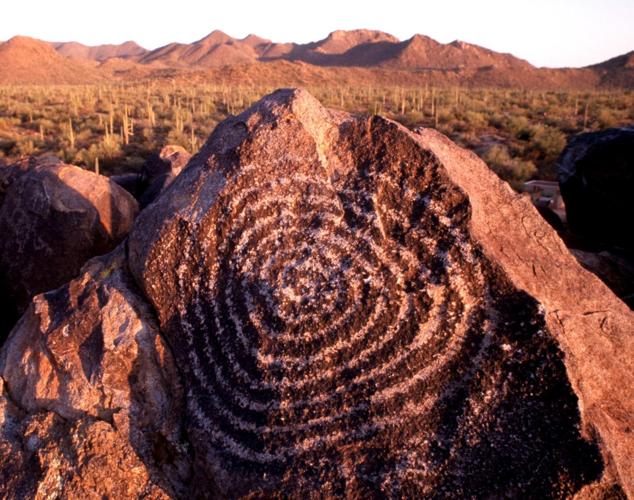Centuries before cellphone photos and social media sites, residents of what is now Tucson had their own way of posting scenes from daily life: They pecked petroglyphs into rocks.
These petroglyphs, images carved into cliffs and boulders, date to as long ago as A.D. 800 — and many are still visible at easy-to-reach sites around the valley.
A loop tour on the western edge of the Tucson area will take you — and perhaps holiday visitors — to a pair of prime petroglyph galleries.
“Whenever I direct people to petroglyphs, Picture Rocks and Signal Hill are the two sites that I most highly recommend,” said Allen Dart, executive director of the Old Pueblo Archaeology Center.
“A lot of the petroglyphs show animal and human figures,” he said. “We see such images on Hohokam pottery from about (A.D.) 800 to 950, so we’re pretty sure that a lot of those glyphs date to that range. But a number of them probably date to about 1350.”
How to get there
One approach to touring the sites is to take Ina Road west of Interstate 10 to Wade Road and follow it south to Picture Rocks Road. The Picture Rocks petroglyphs are along a short trail at the Redemptorist Renewal Center at 7101 W. Picture Rocks Road.
The center’s website notes that visitors are welcome to view the petroglyphs, but visitors are asked to check in at the front office and refrain from climbing on the rocks.
Scores of petroglyphs are visible on a steep rock outcrop at the site. Dart said they include:
- One that looks like a bighorn sheep.
- Another that resembles a deer with a long curly tail.
- Human figures engaged in “what looks like a ritual dance.”
- A large spiral design.
To visit the Signal Hill site, which is in Saguaro National Park West, continue west on Picture Rocks Road to Sandario Road. Turn south on Sandario Road, pass Rudasill and Manville roads, and watch for a left turnoff for Golden Gate Road. Follow Golden Gate Road to a left turnoff for the Signal Hill Picnic area and petroglyph site. A short trail leads uphill to the site.
“There are some dramatic petroglyphs on the south face of the hill,” visible from the trail, Dart said.
“On top of the hill is a large spiral that is often used in pictures promoting Tucson,” he said. “Other petroglyphs are in shapes of humans and animals, and there are a lot of geometric figures.”
Among petroglyphs atop the hill are ones that look a bit like wagon wheels. “But some researchers are interpreting them as flowers,” Dart said.
As at Picture Rocks, visitors are required to stay in a designated viewing area at Signal Hill and refrain from climbing on the rocks.
“It’s important that people not touch the petroglyphs because the oils from your fingers can affect the colors and the research value,” Dart said.
After touring Signal Hill, visitors often return to Sandario Road and continue to Kinney Road and the Saguaro Park visitor center, where day use fees are paid.
Proceeding southeast on Kinney Road brings drivers to Gates Pass Road, which offers a scenic return to Tucson.









